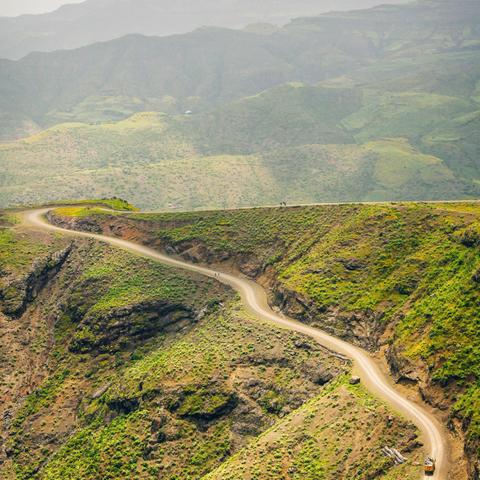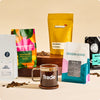There’s so much coffee out in the world—so much. While the immense variety in the coffee industry can be exciting (there will always be something new to try) It can be difficult to look at a bag of beans and figure out if you’ll enjoy what’s inside.
One of the biggest ways we attempt to differentiate beans is by region: most bags list the country the coffee bean was grown in, and many roasters use that information as a way to let consumers know generally how a coffee will taste. Of course, a coffee’s flavor profile is very complex, and where it is grown is just one aspect of its flavor—and today we’ll look at two of the most prized African coffee-growing regions, Ethiopia and Kenya, and discuss the flavors of coffee grown in each region.
Ethiopia: The Birthplace Of Coffee

We wouldn’t have coffee without Ethiopia. You might have heard a story about a goat herder named Kaldi—it’s said that he discovered coffee after noticing how active his goats were after eating from a particular bush (spoiler alert: the bush had coffee cherries). Almost all coffee varieties can be traced back to Ethiopia.
Ethiopia is the fifth largest producer of coffee, producing 6,400,000 60-kg bags of coffee in 2019, which is about 846,575,000 pounds—and about half that coffee stays within Ethiopia and is consumed locally. Coffee grows wild in Ethiopia, so there are a few ways it can be produced and cultivated: from smallholder farms that come together and sell their coffee either as a cooperative or under some other designation (like through a washing station) to larger, single-estate farms.
Most coffee bags include a variety of beans, and almost all bags of Ethiopian coffee beans are labeled as “heirlooms.” This doesn’t mean that all Ethiopian coffees are just one type, but rather quite the opposite: that there are thousands of types of beans that grow throughout the country. If you open a bag of Ethiopian beans, you might see a variety of sizes, shapes, and densities in just one bag. Heirloom generally refers to the idea that a plant or agricultural product has grown in one region for a long time. However, some people are moving away from the word “heirloom” and using the word “landrace.”
It’s difficult to describe the flavors of Ethiopian coffee in one, generalized statement — which is true for all coffee-growing regions! But some common words you might see on bags of Ethiopian coffee are “floral,” “fruity,” and “delicate,”, particularly for washed coffees.
Ethiopia also produces naturally-processed coffees. It’s not uncommon to hear a barista or coffee lover talk about the first experience they had tasting a naturally-processed Ethiopian coffee as a turning point because the flavors are so captivating and apparent right from the first sip.
Truly, you can do no wrong with Ethiopian fresh roasted coffees, and they continue to be some of the world’s most popular beans. You can brew them with any brewing device, but the coffee flavor tends to shine in pour-over coffee or as a single-origin espresso, but I’ve seen coffee shops use Ethiopian coffee beans for their cold brew and French press offerings. However you brew them, it’ll become clear quickly why coffees from Ethiopia are often regarded as special.
Kenya: Science, Scores, and Size
In general, coffee grows in the southeast region of Ethiopia, and bordering the southeastern part of the country is Kenya, another prized coffee-growing region, but for very different reasons.
Although they share a border in East Africa, Kenya didn’t produce its first crop until 1896. The British controlled coffee production during their colonial rule, and Kenya gained independence in 1963. Kenya is the 16th largest producer of coffee, growing 833,000 60-kg bags of coffee in 2019, or about 110,187,000, less than 20% of what Ethiopia grows.
Coffee farming in Kenya has been very well-studied and there are a lot of systems in place to evaluate quality. Sometimes you’ll notice letters on a bag of Kenyan coffee like, AA or AB—these letters refer to the size of the beans since it was thought that quality could be tied back to size, and larger coffee beans were often sold for more money. If you open a bag of Kenyan coffee, you’ll see that beans are much larger than most specialty coffees from other regions.
Almost all offerings of Kenyan coffee beans are washed. Common varieties include SL-28 and SL-34, two varieties identified by a laboratory as being high quality and advantageous to grow agriculturally. However, other varieties are also prominent like Batian (developed at the Coffee Research Station and released in 2010), K7, and Ruiru 11.
Kenyan beans tend to be incredibly flavorful. Common descriptors include “tart,” “stone fruit,” and “dense,” and these coffees shine when their flavors can be come through fully—pour-over brew methods serve the complexity of Kenyan coffee flavor profiles, but they can easily be brewed through other methods.
How To Pick
Short answer: don’t choose! Have both! Coffees from Ethiopia and Kenya are beloved for a reason, but they’re also incredibly different. What they do share in common is complexity—you can brew hundreds of cups of coffee from each region and discover something new to enjoy each time.
As fanatic coffee drinkers, we’re big fans of comparative tasting here, so if you want to distill each African coffee flavor, try tasting the types side by side. Brew up a cup of each and try to describe each roast: does one taste sweeter, more tart, heavier on the tongue? It can be difficult to discern flavors on their own, but tasting two coffees next to each other can help make flavors more apparent.
And no matter which you choose for your brewing experiments, most roasters will have at least one offering from each East African country. Go forth and have fun brewing!
If you’re looking to expand your coffee palette, Trade is here to help. Take our coffee quiz to discover the best brew for you.
Sources
- https://sprudge.com/what-is-heirloom-coffee-190755.html






